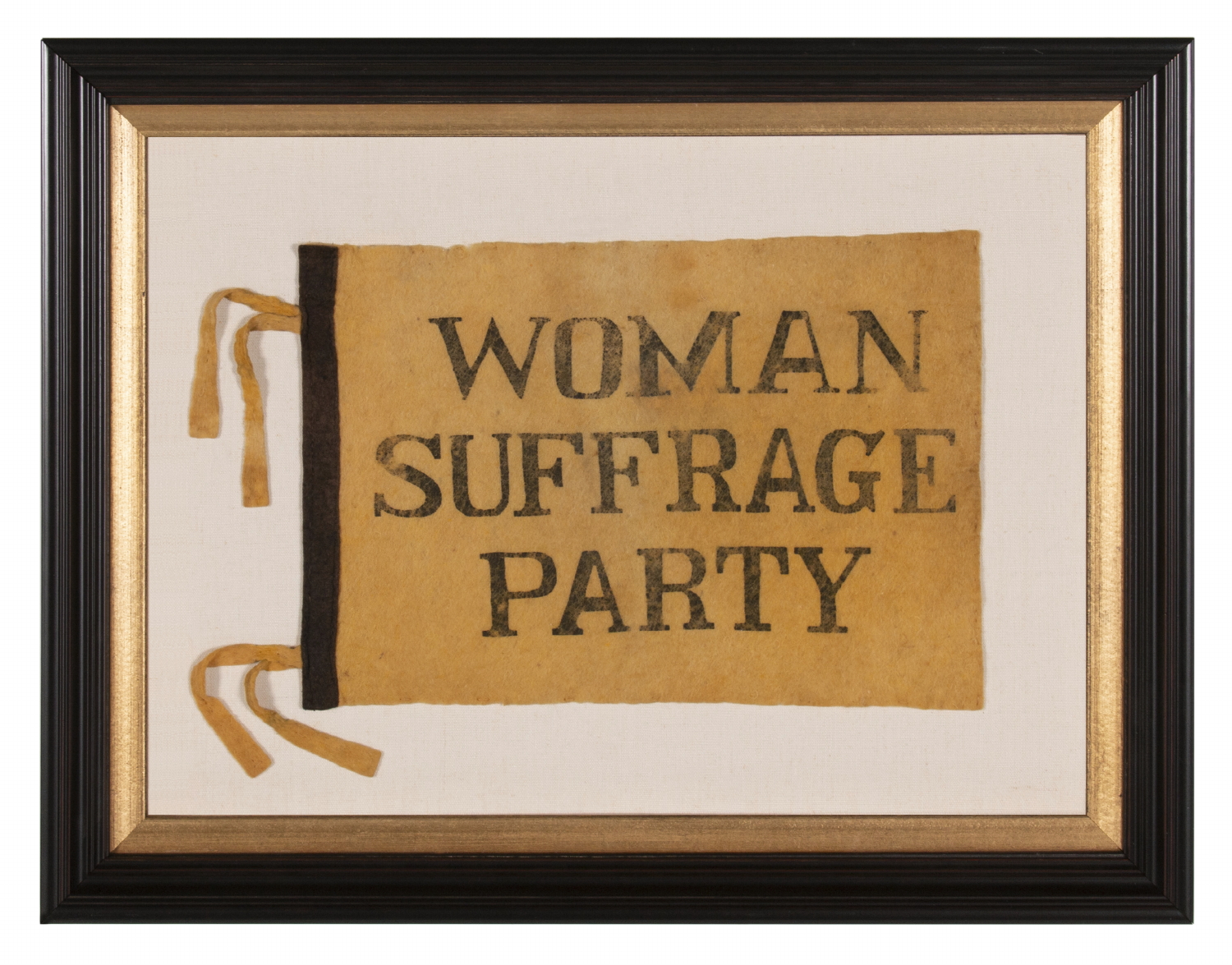
| |
YELLOW FELT SUFFRAGETTE FLAG, MADE FOR CARRIE CHAPMAN CATT'S "WOMAN SUFFRAGE PARTY" OF NEW YORK CITY, CA 1912-20, THE ONLY EXAMPLE THAT I HAVE EVER ENCOUNTERED, CA 1910-20, FOUND WITH A LETTER FROM THE EXECUTIVE SECRETARY OF THE WOMAN SUFFRAGE HEADQUARTERS OF PHILADELPHIA |
|
| Available: |
Sold |
| Frame Size (H x L): |
17.25" x 22" |
| Flag Size (H x L): |
9" x 13.25" |
|
| Description....: |
|
Felt suffragette flag, made of felt, with printed black lettering that reads: "Woman Suffrage Party," on a cheddar yellow ground, There is a black binding along the hoist end with two sets of yellow felt ties.
Founded in 1909 as the "Woman's Party," and changing its name soon thereafter, the WSP was a New York organization formed by Carrie Chapman Catt at something called the "Convention of Disfranchised Women." Held at Carnegie Hall, the event, sponsored by Catt's Interurban Suffrage Council, brought together a host of local suffrage groups, organizing them into a new political machine.
Yellow was the customary color of the suffrage movement in America, coupled with a variety of subordinate colors, primarily black on felt textiles. Violet and green were the traditional colors of the women's movement in England, though these sometimes appear in the States.
The flag is constructed in the same manner as felt Suffrage pennants of the same period, which are iconic objects of the movement. Even though they were so popular at the time, pennants are extremely scarce today and are extremely sought after among Suffrage collectors. I have been fortunate to have owned numerous examples, including some of the most rare and wonderful varieties, but I have never before encountered a felt flag. This is an unrecorded form and I was previously unaware that it existed.
Suffrage banners, though rare in the marketplace, were a prominent fixture in rallies and parades, well documented in almost countless period photographs. Flags, on the other hand, are seldom ever seen in early images of the same. One may come across them on rare occasion in photographs, but this felt example is the first that I have ever personally owned or encountered in any form.
The flag was found in a California estate of a woman with the maiden name of McFarland, whose family originated in Philadelphia. Accompanying it was a hand-written letter, on the formally printed letterhead of Miss Caroline Katzenstein, Executive Secretary of the Woman Suffrage Headquarters of Philadelphia. The letterhead bears a Philadelphia Union Bee, meaning that it was printed with union labor. Though undated, the letter was certainly written during the early 20th century. Unfortunately much of the content of the text is illegible, due to poor handwriting. I have yet to take the opportunity to explore the relationship between McFarland and Katzenstein further to see if there was a familial connection.
More Information on Carrie Chapman Catt and the Woman Suffrage Party:
The following record of the initial meeting of the WSP was recorded in The News-Palladium under the heading: "Suffragists Party a Reality, Born at First Political Convention of Disfranchised":
New York, Oct. 30. [1909]--The woman's party is no longer a theory but a reality, and Mrs. Carrie Chapman-Catt is its chairman. It was born at the first political convention of disfranchised women last night in Carnegie Hall, with all the prestige that could be imparted by the brains, wealth, and beauty of the movement to obtain the ballot for women.
The whole tone of the rally, under the auspices of the Interurban Suffrage Council, was kept within conservative limits as a tacit protest against the Pankhurst meeting and the militant methods involved. It is understood that so fixed was the determination of Mrs. Clarence Mackay, chairwoman of the platform committee, to keep the demands reasonable and dignified that she refused to permit the insertion of two planks which verged on sensationalism or suggested partisanship.
It was on this score that the "white slave" question was untouched and that the platform, which Mrs. Mackay read, asked such action as concerns women's position as a civic and national factor.
With the help of Mary Garrett Hay, Catt organized the WSP like the Democratic Party, with representatives from each assembly district. Organizers in many other states and cities soon followed, organizing on a local level so that every election district was covered. 804 delegates were sent to the original meeting, and by 1915, when the suffrage issue came to a vote for the first time in New York State, WSP membership was 100,000 strong. The vote was lost in that year, but passed just two years later, in 1917, and New York became the first eastern state to give women the right to vote.
Mounting: The pennant has been hand-stitched to 100% hemp fabric or a hemp and cotton blend (we use both interchangeably). The mount was placed in a modern molding with a step-down profile and a finish that is very dark brown, almost black, with red undertones and highlights, to which a black-painted and hand-gilded Italian molding was added as a liner. Spacers keep the textile away from the glazing, which is U.V. protective glass.
Condition: There is some pigment loss in the black lettering and there is some soiling throughout. Professional cleaning was undertaken. The intensity of some soiling was reduced with a reversible medium. There is some fabric weakness along the upper edge, about 1/5th of the way out from the hoist end. |
|
|
|
| Collector Level: |
Advanced Collectors and the Person with Everything |
|
| Flag Type: |
Parade flag |
|
| Star Count: |
|
|
| Earliest Date of Origin: |
1910 |
|
| Latest Date of Origin: |
1920 |
|
| State/Affiliation: |
Pennsylvania |
|
| War Association: |
|
|
| Price: |
SOLD |
|
| |
Views: 605 |
|
|
|

